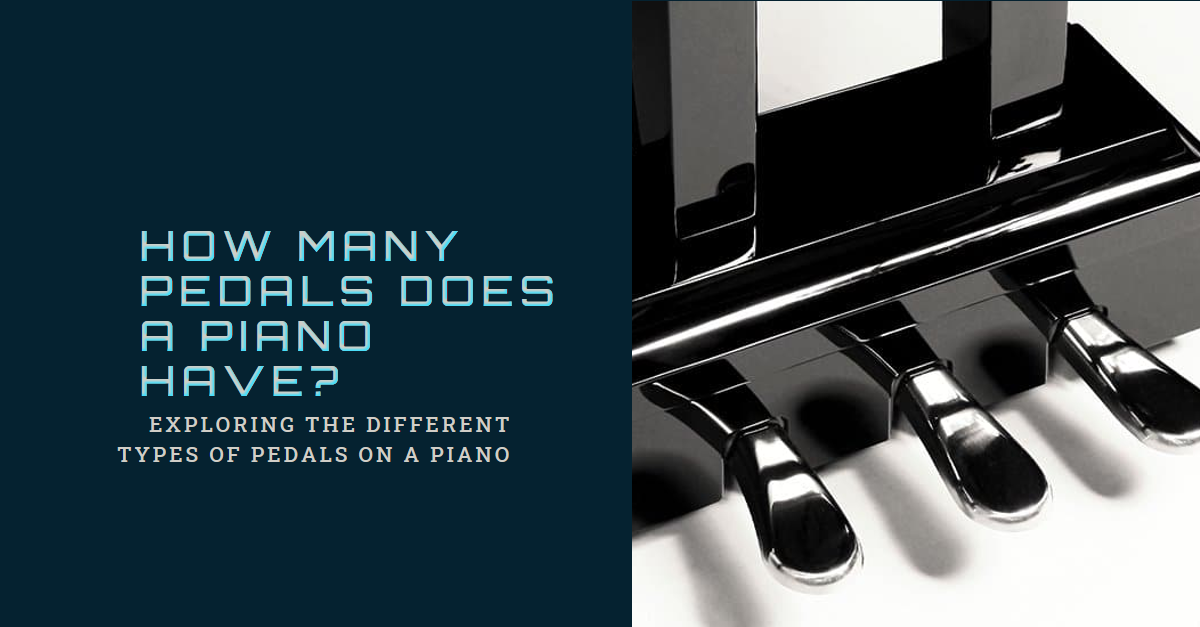A piano is a musical instrument classified as a percussion instrument and a stringed instrument. The piano produces sound when its keys are pressed, which makes hammers inside the piano strike strings tuned to specific pitches.
An important part of playing the piano is the use of pedals located at the base of the instrument. Piano pedals allow pianists to modify the timbre and sustain of the music they are playing, enhancing expression and control. But how many pedals does a typical piano have?
Number of Pedals
The number of pedals found on pianos can vary depending on factors like the age of the instrument and its intended purpose. However, most modern pianos have three pedals.
Modern Pianos

The vast majority of modern acoustic and digital pianos are equipped with three-foot pedals:
| Pedal | Function |
|---|---|
| Soft pedal (una corda) | Makes the piano sound slightly softer and more muted |
| Sostenuto pedal | Sustains specific notes selected while allowing subsequent notes played to sound normally |
| Sustaining pedal (damper pedal) | Sustains the sound of all notes played while the pedal is depressed |
Soft Pedal
The soft pedal, also called the una corda pedal, is the left-most pedal on most pianos. When activated, it shifts the piano action slightly to the right so that fewer strings are struck by the hammers for each note, resulting in a more muted and subdued sound.
The soft pedal allows pianists to play mezzo-piano and piano dynamics more easily. It is commonly used for quieter passages that are meant to be delicate and lyrical.
Sostenuto Pedal
The sostenuto pedal is the middle pedal on most modern pianos. It allows pianists to sustain specific notes on the piano while other notes remain unaffected. This way, certain notes can be prolonged while others notes can be played staccato.
The sostenuto pedal is useful for pedaling dissonant notes in contemporary classical music while allowing their surrounding notes to decay naturally. It provides more subtlety and selectivity than the sustain pedal.
Sustaining Pedal
The sustain pedal also called the damper pedal, is located on the right of most pianos. It is the most commonly used piano pedal.
When depressed, the sustain pedal lifts all the dampers off the piano strings at once. This allows all the strings that have been struck to vibrate freely, causing notes played on the piano to sustain until the pedal is released.
This creates a richer, more resonant sound as additional overtones can be heard. The sustain pedal smooths out the decay of notes and helps connect successive notes, creating a legato effect.
Proper use of the sustain pedal is a key skill for pianists to develop. Pedal markings in sheet music instruct pianists when to depress and release the sustain pedal.
Older Pianos
While modern pianos typically have three pedals, older pianos often have fewer pedals:
- Most late 19th century and older upright pianos only have two pedals – the una corda soft pedal and the damper sustain pedal. The middle sostenuto pedal is usually absent.
- Many mid-19th century grand pianos also may only have two pedals instead of three. Some early 5-pedal models also existed.
So if you have a particularly old piano, chances are it may not have a middle sostenuto pedal. However, the two standard pedals – the soft pedal and the sustain pedal – are consistently present on most pianos.
Variations
While the three-pedal configuration covers most pianos, some instruments break the mould:
- Four-pedal pianos – Some pianos have a fourth “half-blow” pedal on the far left that further reduces hammer strike force, beyond the soft pedal. This allows extremely subtle pianississimo playing.
- Alternative middle pedals – Many upright pianos replace the middle sostenuto pedal with a “practice pedal” that inserts a piece of felt to mute notes. This allows for quiet practice without disturbing others. Some pianos may have a middle “bass sustain” pedal instead, which only sustains the lowest bass notes.
So if you ever encounter a piano with four pedals or strange alternative middle pedals, don’t be alarmed! These are variations that exist on some models for specific purposes.
Factors Affecting Number of Pedals
The number of pedals seen on pianos ultimately depends on several factors:
- Age – Older pianos tend to have fewer pedals. The sostenuto pedal only became common in the 20th century.
- Brand – Certain piano brands have signature variants like four-pedal models. Number of pedals can also differ across budget tiers.
- Intended use – Home pianos may prioritize practice pedals. Concert models offer more possibilities like sostenuto control.
- Genre/style – Jazz pianos rarely use the sostenuto pedal, so may lack one. Classical pianos require all three for repertoire.
So when inspecting a piano, the age, brand, purpose, and style it’s designed for all contribute to configurations with two, three, or sometimes four pedals.
Conclusion
While most pianos have three pedals, the number can vary from two to four depending on the age and model. But no matter the piano, familiarity with these pedals – the soft una corda, the sostenuto, and the all-important sustain pedal – is essential for pianists learning to control dynamics and expression.
Understanding the capabilities of piano pedals allows you to better translate composers’ intentions when interpreting pieces. With the power to mute, sustain, and colour piano notes, mastering piano pedals is integral towards unlocking the possibilities of the instrument.





